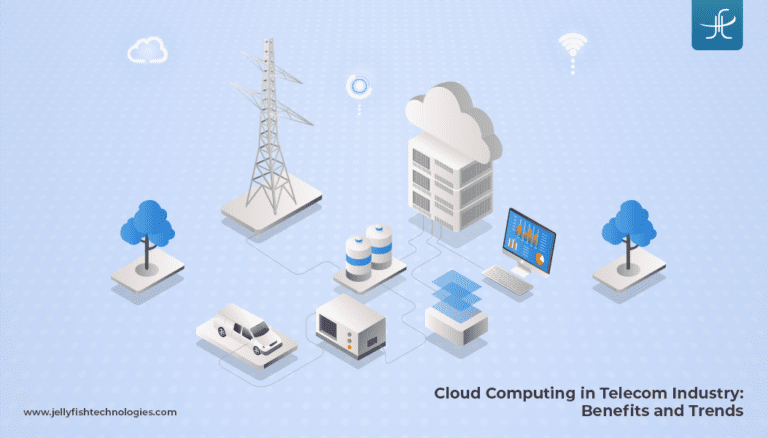Cloud computing isn’t merely a buzzword anymore; it’s a transformative force reshaping industries worldwide, from IT to manufacturing. Now, its impact is reverberating within the telecom industry, promising innovative solutions for the long haul.
In recent years, cloud computing has emerged as the backbone of telecom’s digital evolution, empowering companies to efficiently manage customer data, establish cloud-based data hubs, seamlessly transition data to the cloud, and streamline access to telecom services – all autonomously.
According to the latest findings from MARKETS AND MARKETS, the revenue generated by the telecom cloud market surpassed a staggering $11.5 billion in 2022. Moreover, with a projected Compound Annual Growth Rate (CAGR) of 23.1%, this market is expected to surpass $32.5 billion by 2027, underscoring the telecom industry’s unwavering commitment to embracing cloud-based solutions.
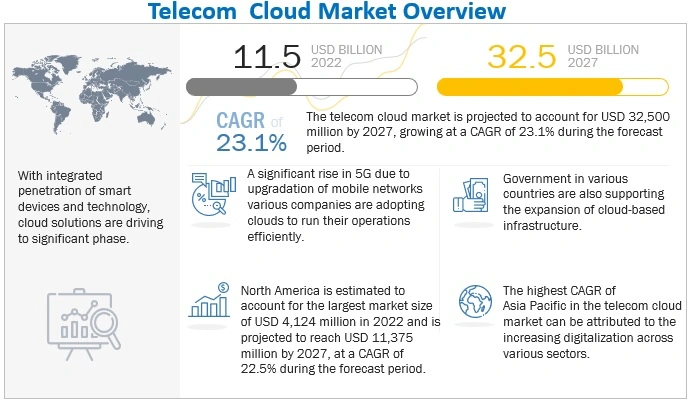
The possibilities with cloud computing in telecom are boundless. So, let’s delve deeper to discover its advantages, explore its different types, and stay ahead of the latest trends in this transformative field.
What is Cloud Computing in Telecom?
Cloud computing in the telecom industry refers to the utilization of virtualized infrastructure and software-driven solutions to deliver and manage telecommunications services. This approach enables telecom companies to access computing resources over the Internet on an on-demand basis, eliminating the need for traditional hardware infrastructure.
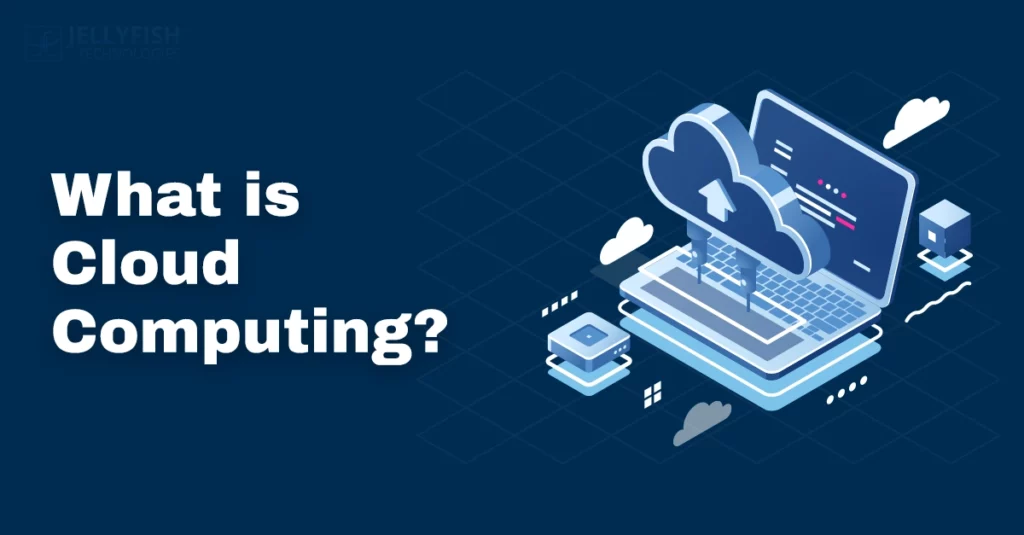
By centralizing resources and optimizing utilization, cloud computing in telecom streamlines operations and facilitates rapid deployment of new services and applications to meet evolving market demands.
Let’s now learn about the different types of cloud computing in telecommunications.
Types of Cloud Computing
| Aspect | Public Cloud | Private Cloud | Hybrid Cloud | Multi-Cloud |
|---|---|---|---|---|
| Ownership | Owned and operated by a third-party cloud service provider | Owned and operated by the organization or a third party | Combination of public and private cloud infrastructure | Utilizes services from multiple cloud providers |
| Accessibility | Generally accessible to the public via the internet | Restricted access typically limited to organization | Accessible both publicly and privately | Accessible across multiple cloud platforms |
| Scalability | Highly scalable, resources can be dynamically provisioned | Scalability may be limited based on infrastructure | Offers scalability by utilizing both public and private resources | Scalable across multiple cloud providers |
| Control | Limited control over infrastructure and security settings | Full control over infrastructure and security settings | Varies depending on the deployment model | Control may vary depending on the cloud service providers |
| Security | Security is managed by the cloud service provider | Security is managed by the organization’s IT team | Security measures vary depending on the deployment model | Security policies may vary across cloud providers |
Types of Cloud Computing for Telecom Businesses
Cloud computing offers telecom companies a plethora of options to enhance their operations, streamline processes, and deliver innovative services to customers. From public and private clouds to hybrid and multi-cloud environments, each type of cloud computing deployment model offers unique advantages and considerations for telecom businesses.
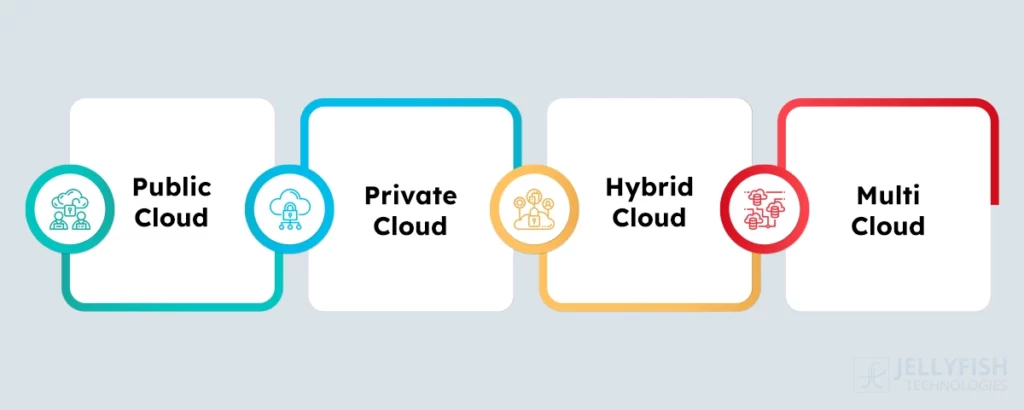
Public Cloud
Public cloud services, offered by third-party providers, allow telecommunication companies to access computing resources, such as servers and storage, over the internet. These services are cost-effective and scalable, making them ideal for telecom businesses looking to rapidly deploy new services and applications.
Private Cloud
Private cloud environments, hosted either on-premises or by a third-party provider, offer enhanced security and control over data and resources. Telecommunication companies may opt for private clouds to meet regulatory requirements or maintain sensitive data within their infrastructure.
Hybrid Cloud
Hybrid cloud environments combine the benefits of public and private clouds, allowing telecommunication companies to leverage the scalability of public clouds while retaining control over critical data and applications in private environments. This flexibility enables telecom companies to optimize cost-efficiency and performance based on their specific needs.
Multi-Cloud
Multi-cloud strategies involve the use of multiple cloud providers to distribute workloads and mitigate risk. Telecommunication businesses may adopt a multi-cloud approach to avoid vendor lock-in, maximize reliability, and access specialized services from different providers.
Models of Cloud Computing in the Telecom Industry
Software as a Service (SaaS)
SaaS delivers software applications over the internet on a subscription basis. Telecom companies can leverage SaaS solutions to access and use applications without the need for installation or maintenance. This model offers convenience, scalability, and cost-effectiveness, enabling telecom businesses to access a wide range of applications, such as customer relationship management (CRM), billing systems, and analytics platforms, to streamline operations and enhance customer experiences.
Infrastructure as a Service (IaaS)
IaaS provides virtualized computing resources, such as servers, storage, and networking, over the Internet. Telecom businesses have full control over the operating systems, applications, and development frameworks running on the infrastructure. IaaS offers scalability and flexibility, enabling telecom companies to dynamically provision resources based on demand.
Platform as a Service (PaaS)
PaaS offers a platform for developers to build, deploy, and manage applications without the complexity of managing the underlying infrastructure. PaaS providers offer development and deployment environments, including tools, libraries, and runtime environments, to streamline the application development process. PaaS accelerates application delivery and enables innovation in the telecom industry.
Benefits of Cloud Computing in the Telecom Industry
From scalability and operational efficiency to innovation and cost optimization, cloud computing has become an indispensable tool in driving growth and success in the telecom industry.
In this section, we explore the diverse benefits of cloud computing from different perspectives within the telecom industry, highlighting its transformative impact and potential for driving innovation and competitiveness.
Advantages of Cloud Computing: Telecommunications Point of View
Scalability
Cloud computing in the telecom industry dynamically scales resources according to demand, ensuring both optimal performance and cost efficiency.
Operational Efficiency
Centralizing infrastructure and automating tasks through cloud computing streamlines operations, leading to improved efficiency and reduced overhead costs.
Innovation
Cloud computing in telecom innovates and deploys new services rapidly, allowing companies to stay ahead of the competition and meet evolving customer demands.
Advantages of Cloud Computing: Service Provider’s Point of View
Service Expansion
Cloud computing allows telecom service providers to offer a broader range of services, including voice, data, and multimedia communication, with greater flexibility and efficiency.
Improved Quality and Reliability
Leveraging advanced technologies like virtualization and software-defined networking enhances service quality and reliability for service providers and their customers.
Cost Optimization
Cloud computing in telecommunications allows service providers to optimize resource utilization, reducing capital expenditures and improving profitability in a competitive market landscape.

Advantages of Cloud Computing: Telecommunications User’s Point of View
Flexibility and Accessibility
Cloud computing in the telecommunications industry offers users greater flexibility and accessibility, allowing them to access communication and collaboration tools from any device and location with an internet connection.
Reliability and Performance
Users benefit from enhanced reliability and performance as cloud computing services are delivered from redundant and geographically distributed data centers.
Affordability
Cloud computing services often come with lower costs and greater affordability as users only pay for the resources they consume, eliminating the need for upfront investments in hardware and infrastructure.
In summary, cloud computing in the telecom industry offers scalability, efficiency, agility, reliability, and cost-effectiveness from various perspectives. However, it is important to select the right cloud platform to fully harness these advantages.
Also read: AWS vs Azure vs Google Cloud – Which Cloud Platform is Best for Your Business
Top 8 Trends of Cloud Computing in Telecommunications
Edge Computing Integration
In response to the increasing demand for low-latency services, such as the Internet of Things (IoT) and 5G, telecom companies are strategically integrating edge computing into their cloud infrastructure. Edge computing enables data processing and analysis to occur closer to the source of data generation, reducing latency and improving the overall performance of latency-sensitive applications.
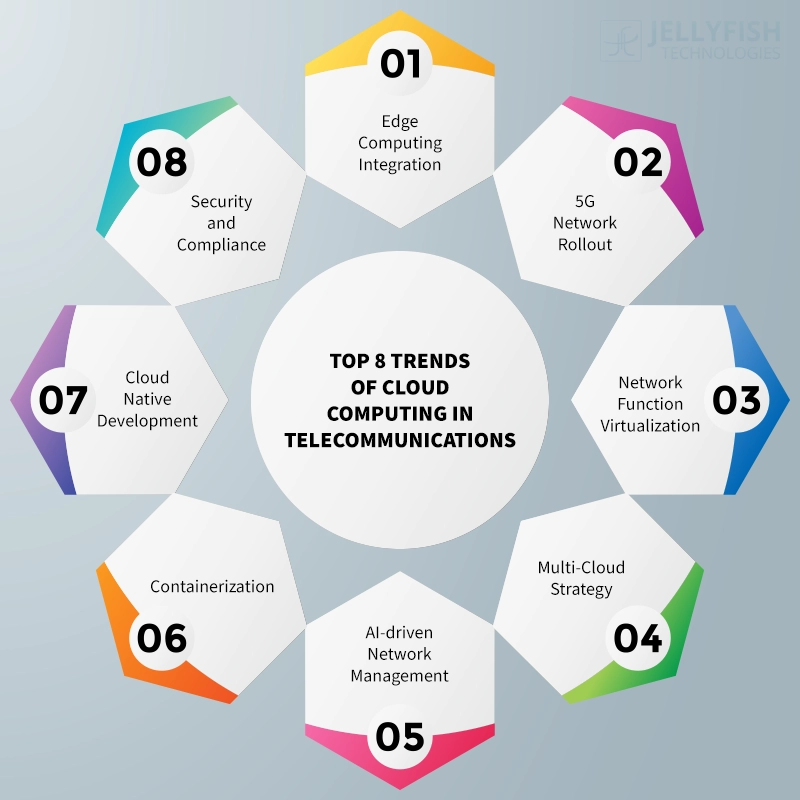
By deploying edge computing nodes at the network edge, telecom companies can deliver faster response times and enhanced user experiences, particularly in scenarios where real-time data processing is critical, such as autonomous vehicles, industrial automation, and augmented reality applications.
5G Network Rollout
The widespread deployment of 5G networks represents a monumental shift in the telecommunications landscape, ushering in a new era of connectivity characterized by faster speeds, lower latency, and increased network capacity. Cloud computing plays a pivotal role in supporting 5G infrastructure, enabling telecom operators to build agile, scalable, and software-defined networks that can efficiently deliver next-generation services.
With 5G, telecom companies are leveraging cloud-native architectures and technologies to virtualize network functions, automate operations, and rapidly deploy innovative services such as augmented reality, virtual reality, and immersive gaming.
Network Function Virtualization (NFV)
NFV continues to be a fundamental trend shaping the evolution of cloud computing in telecommunications. NFV enables telecom companies to decouple network functions from proprietary hardware appliances and deploy them as software-based services on standard, virtualized infrastructure.
By virtualizing network functions, such as firewalls, load balancers, and routers, telecom companies can achieve greater flexibility, scalability, and cost-efficiency in managing their network infrastructure. NFV also facilitates the rapid introduction of new services, reduces time-to-market for innovations, and enhances the overall agility of telecommunications networks.
Multi-Cloud Strategy
Recognizing the importance of avoiding vendor lock-in and optimizing performance, telecom companies are increasingly adopting multi-cloud strategies to leverage the strengths of multiple cloud providers. Multi-cloud environments enable telecom companies to distribute workloads across different cloud platforms based on specific requirements such as performance, compliance, and cost.
By diversifying their cloud infrastructure, telecommunication companies can enhance redundancy, mitigate risks, and optimize performance for different types of applications and workloads. Additionally, multi-cloud strategies empower telecom companies to negotiate better terms with cloud providers, optimize costs, and maintain flexibility in their cloud deployments.
AI-driven Network Management
Telecom companies are leveraging AI and ML algorithms to analyze vast amounts of network data, identify patterns, and proactively optimize network performance and efficiency. AI-driven network management solutions can automatically detect anomalies, predict network failures, and dynamically adjust resources to meet changing demand, thereby improving service quality, reducing downtime, and enhancing overall customer satisfaction.
By harnessing the power of AI, telecom companies can transform their network operations from reactive to proactive, enabling them to deliver superior services in an increasingly competitive market.
Containerization
Containerization technologies, such as Kubernetes, are gaining traction in telecom cloud computing as operators seek more efficient ways to manage and orchestrate containerized workloads at scale. Containers offer a lightweight and portable solution for deploying applications in cloud environments, providing telecom operators with greater agility, flexibility, and resource utilization compared to traditional virtual machines.
Also read: 6 Steps to Implement and Build a Successful Cloud Migration Strategy
By adopting containerization, telecom companies can accelerate the development and deployment of cloud-native applications, streamline DevOps processes, and achieve greater consistency and portability across hybrid and multi-cloud environments. Container orchestration platforms like Kubernetes further enhance the scalability, resilience, and automation of containerized workloads, enabling telecom operators to build and manage complex distributed systems with ease.
Cloud-Native Development
Telecom companies are embracing cloud-native development practices to build, deploy, and manage applications more efficiently in cloud environments. Cloud-native development emphasizes the use of containerization, microservices architecture, and continuous integration/continuous delivery (CI/CD) pipelines to enable faster development cycles, greater scalability, and improved resilience.
By adopting cloud-native principles, telecommunications companies can break down monolithic applications into smaller, independent microservices that can be developed, deployed, and scaled independently. Furthermore, this modular approach to application development enables telecom companies to innovate more rapidly, respond to market demands more effectively, and deliver a superior user experience to their customers.
Security and Compliance
With the increasing adoption of cloud computing in telecommunications, there is a growing focus on security and compliance to protect sensitive data and ensure regulatory compliance.
Cloud security solutions such as encryption, access control, and threat detection help mitigate risks and enhance the resilience of telecom cloud environments against cyber attacks. By prioritizing security and compliance, telecom companies can build a strong foundation for their cloud deployments and mitigate potential risks associated with data breaches, regulatory fines, and reputational damage.
Conclusion
Embracing cloud technologies enables telecom companies to modernize their infrastructure, streamline operations, and deliver enhanced services to their customers. Whether it’s leveraging the scalability of public clouds, the security of private clouds, or the flexibility of hybrid deployments, cloud computing empowers telecom operators to stay agile, responsive, and ahead of the curve in today’s rapidly evolving digital landscape.
As organizations navigate the complexities of cloud adoption and optimization, partnering with a trusted cloud consulting services company like Jellyfish Technologies can make all the difference. With our expertise in cloud architecture, migration, and optimization, we empower telecom companies to unlock the full potential of cloud computing, streamline operations, and drive business growth.
Whether it’s designing tailored cloud solutions, implementing cutting-edge technologies, or providing ongoing support and optimization, Jellyfish Technologies stands ready to be your trusted partner on your cloud journey. Together, we can harness the power of cloud computing to fuel innovation, enhance agility, and achieve unparalleled success in the telecom industry.
We would love to hear your comments relating to the post. Do you have some other thoughts? Drop us words through our contact page.

